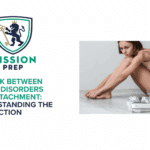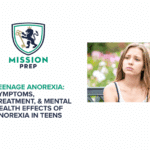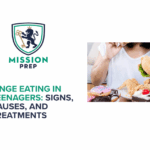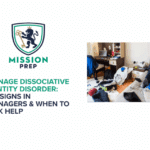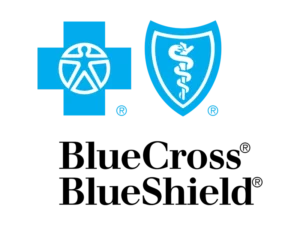Eating Disorders in Teens: A Guide for Families

Eating disorders in teens are not just about dieting, social media trends, or “a phase” – they are serious mental health conditions that affect many families. In fact, around 1 in 5 teens struggle with an eating disorder.¹
An eating disorder refers to abnormal eating behaviors that negatively influence a person’s mental or physical health. They come in different forms: Anorexia Nervosa, Bulimia Nervosa, Binge Eating Disorder, Avoidant/Restrictive Food Intake Disorder, and Other Specified Feeding or Eating Disorders. But more on the different types soon.
If you’re reading this because you’re worried about your teenage or adolescent child, you’re in the right place. This guide provides straightforward answers and practical information about common types of eating disorders teens face and the effects of eating disorders on teens. You’ll also see:
- How eating disorders often overlap with anxiety and depression
- What eating disorder treatment for teenagers can look like (from outpatient therapy to residential eating disorder programs for teens)
- How to support a teen with an eating disorder at home
If your gut says something’s off, listen to it. You don’t need to wait for things to become more obvious or get worse before seeking help.

What Are Eating Disorders in Teens?
Eating disorders are mental illnesses that can affect a person of any age (including teens), background, gender, ethnicity, and so on. They revolve around an unhealthy relationship with food, body image, and weight, and surface as unhealthy eating behaviors, such as:²
- Restricting the amount of food eaten
- Removing eaten food (through making oneself sick or using laxatives)
- Excessive exercising after eating
- Eating lots of food in one sitting
Current stats show that roughly 5.5% – 17.9% of young women are affected by some form of eating disorder, compared to up to 2.4% in young men worldwide.3 While these figures suggest that many more women are affected than men, it’s important to bear in mind that eating disorders are typically more often recognized in women, and they may be underdiagnosed in men.
Types of Eating Disorders in Adolescents
Understanding the common types of eating disorders in teens can make it easier to spot the signs and get timely treatment for a teen. The most discussed categories of EDs are Anorexia Nervosa, Bulimia Nervosa, Binge Eating Disorder, Avoidant/Restrictive Food Intake Disorder, and Other Specified Feeding or Eating Disorder. Let’s explore each in more detail.
1. Anorexia Nervosa (AN)
Teens with Anorexia Nervosa severely restrict their food intake, often consuming far fewer calories than their bodies need. They typically have an intense fear of weight gain and distorted views of their body, seeing themselves as far larger than they are.
Over time, AN can lead to extreme weight loss, hormonal changes, fatigue, and dizziness. It can also disrupt regular heart rhythms, lead to changes in menstrual cycles in girls, and affect fertility and overall cognitive function.4
2. Bulimia Nervosa
Bulimia Nervosa involves cycles of eating unusually large amounts of food (binges) followed by purging behaviors such as vomiting, using laxatives, or intense workouts. Unlike anorexia, teens with bulimia nervosa may remain at a “normal” weight range, which can make the condition more difficult to spot.
Unfortunately, the binge–purge cycle can damage the heart, teeth, and gut, and can destabilize electrolytes and salts that the body needs to stay balanced.²
3. Binge Eating Disorder (BED)
With Binge Eating Disorder, teens have recurring episodes of eating large amounts of food quickly, and often in secret. They may experience a lack of control during these episodes, followed by intense shame, guilt, and discomfort. Unlike bulimia, those with BED don’t purge afterward.
BED can contribute to weight gain, metabolic issues, and often coexists with anxiety or depression.²
4. Avoidant/Restrictive Food Intake Disorder (ARFID)
ARFID involves avoiding specific foods or entire food groups due to sensory sensitivities, fear of choking or vomiting, or just no interest in eating. Unlike anorexia or bulimia, ARFID isn’t driven by fears around gaining weight or body shape changes.
ARFID can cause low bone density, nutrient deficiency in the body, constipation, affect mental and physical growth, and cause a great deal of stress for the family at mealtimes.²
5. Other Specified Feeding or Eating Disorder (OSFED)
OSFED includes eating disorders that don’t fit the full criteria for any of the conditions we’ve spoken about above. For example, a teen might have some features of anorexia or bulimia, while also displaying other symptoms not associated with either. OSFED can be just as risky as other diagnoses and requires the same level of care.
Recognizing the types of eating disorders adolescents face can be the first step in asking the right questions and finding a treatment that fits your, or your loved one’s, needs.
Warning Signs of Eating Disorders in Adolescents
Physical Signs of Eating Disorders in Teens
Noticeable weight changes (up or down), slowed growth, dizziness or fainting, headaches, feeling cold, low energy, changes in the condition of hair, nails, or skin, period changes, or delays in puberty.
Behavioral Signs of Teen Eating Disorders
Skipping meals, cutting out specific food groups, rigid food “rules,” bingeing, secretive eating, frequent bathroom trips after meals, chewing ice cubes, hoarding food, excessive exercise, and distress if routines are interrupted.
Emotional and Social Changes of Teen Disorders Eating
Mood changes, increased perfectionism or irritability, withdrawal from friends or activities, body-checking, mirror obsession or avoidance, anxiety, depressed mood, low self-esteem, and black-and-white thinking about food (“good/bad”).
Eating Disorders and Mental Health in Teens
You may notice your teen becoming more rigid (rules about timings, types of food, exercise, or routines), more avoidant (skipping social events that involve food), or more self-critical (constant struggle with clothes and how they fit).
Eating disorders and depression in teenagers can feed off each other: Malnutrition worsens mood and concentration; low mood and anxiety make recovery feel harder.6
Effects of Eating Disorders on Teens
Eating disorders in teens affect every part of their body and have far-reaching long-term effects⁴ – especially during their growing years.
- Heart and circulation: Slow heart rate, low blood pressure, dizziness on standing, palpitations.
- Bones and growth: Lower bone mineral density, delayed or stalled growth, higher fracture risk.
- Brain and mood: Poor concentration, memory issues, increased anxiety or depression, sleep problems.
- Digestive system: Bloating, constipation, abdominal pain; with purging—esophageal irritation, dental enamel loss.
- Hormones: Irregular or missed periods, disrupted puberty, thyroid changes.
- Energy and immunity: Fatigue, feeling cold, frequent illness, and slower injury healing.
However, it’s important to note that not every teen looks “unwell.” Medical risk can be high even when their weight looks typical. Weight is just one data point; vital signs, labs, and growth history are crucial indicators of what’s going on below the surface.
Red Flags for Urgent Care
If any of the following signs are present, please seek medical help immediately:
- Fainting
- Chest pain
- Palpitations
- Very low energy
- Self-harm or suicidal thoughts
- Rapid weight loss
- Inability to keep food or fluids down
Getting Help for Teen Eating Disorders
If you’re a teen noticing a change in yourself, or a parent noticing sudden changes in your teen, it can be difficult knowing what to do. Let’s dive into the ways you can reach out for help during this time.
Step 1: See Your Pediatrician or GP
Ask for vitals (including orthostatic blood pressure and heart rate), weight and height trends, and labs (including kidney, liver, and electrolytes). Keep a diary and share specific behaviors and changes you’ve noticed in their eating, sleep and daily mood. Use the SCOFF questionnaire to check if any of the warning signs of an eating disorder are present.7
Step 2: Ask for an Eating-Disorder-Informed Referral.
Look for experienced clinicians and programs for teenagers. If you’re offered general counseling without eating-disorder expertise, keep looking.
Step 3: Build a Circle of Support
Tell the school you’re pursuing care; ask about accommodations for meals, breaks, or reduced PE if needed. Consider joining local or online parent support groups. Keep in mind, these groups are not a substitute for medical advice or professional support, but a great support system to have alongside.
When in doubt, consider discussing things with your teen or family doctor about getting teenage eating disorder help. Earlier intervention is almost always easier than catching up after a crisis.
Treatment Options for Teens With Disordered Eating
- Outpatient Care: This can include weekly or biweekly therapy and dietitian sessions, medical monitoring by your GP or pediatrician. This type of care is best for early or stable cases of eating disorders, and where support at home is consistent.
- Intensive Outpatient Program (IOP): This involves attending a program (in-person or virtually), several hours per day, multiple days per week. This helps to add structured meals and group sessions that your teen attends, whilst living at home.
- Partial Hospitalization Program (PHP) / Day Program: If the eating disorder is more advanced or support at home is limited, the teen can spend most of the day in treatment with supervised meals; whilst being at home in the evenings.
- Inpatient Hospitalization: Short-term medical stabilization for urgent risks (for example, severe electrolyte disturbances, very low heart rate, or inability to keep food down).
It can help to ask providers which model they’re using, as this will allow you to make an informed choice about what suits your teen best. Two strong evidence-based options that are commonly used within these treatment programs for teens with disordered eating are:
Family-Based Treatment (FBT)
FBT is a structured approach where you, as the parents or caregiver, temporarily take the lead on nutrition and meals while the care team coaches you. This typically looks like planned, consistent meals and snacks; parents setting limits around exercise and compensatory behaviors, and the care team monitoring medical safety and progress. Control moves back to your teen gradually as their health improves.
This approach can be helpful as teens with disordered eating often feel overwhelmed by decisions around food. FBT lowers that burden and restores medical stability faster.
Cognitive Behavioral Therapy—Enhanced (CBT-E)
CBT-E is a structured, time-limited therapy that targets the thoughts, emotions, and behaviors that fuel a teen’s eating disorder. This approach helps to build flexible thinking around food, reduces body-image distress, and teaches relapse-prevention skills.
CBT-E is often used for bulimia and binge eating disorder, but can help across other diagnoses.
How to Support a Teen With an Eating Disorder
Before we get into the tips, know this: You don’t have to be perfect, you just need to support your teen in finding the best path for recovery. Here’s what you can do:
- Provide structure. Plan three meals and several snacks at consistent times. Sit with your teen at meals; reduce distractions, keep conversation neutral and supportive.
- Avoid diet talk. Ditch labels like “good” and “bad” foods. Focus on nourishment, not numbers.
- Limit compensatory behaviors. Work with the medical team to set clear limits around exercise, bathroom time after meals, or other rituals that keep symptoms going.
- Validate first and listen to them. “I can see this is really hard.” Your teen is not the problem; the illness is.
- Praise effort, not weight. Notice bravery – finishing a snack, showing up to therapy, trying a feared food – these are all achievements in a difficult journey.
- Expect difficult feelings. Ups and downs are normal during eating disorder recovery in teenagers. Show patience and consistency in the face of resistance and pushback.
- Get a clear treatment plan. Seek support from teen mental health professionals as soon as you’re concerned about their wellbeing. Then, once the car team is involved, stay involved. Attend parent sessions, learn coaching skills, and keep an eye on medical signs between appointments.
How to support a teen with an eating disorder is a skill you can learn. You’ll get better at it and feel more confident with practice and guidance.

Teen Mental Health Support At Mission Prep
If you’ve recognized patterns of an eating disorder in your adolescent or teen child, it’s important to help them get the support they require. Rather than hoping it goes away or staying unsure about how to talk about it, reach out for help. Start with your pediatrician or GP, ask for an eating-disorder-informed referral, and keep advocating until your teen has a plan that fits their needs.
At Mission Prep, we want you to know that your teen is more than a diagnosis. While we don’t treat eating disorders directly, we can help teens on their journey to recovery by providing mindfulness-based CBT, art therapy, and somatic therapies to treat underlying issues such as trauma, anxiety, and depression that could be contributing to the eating disorder.
If You Need Urgent Help Now
- Emergency: Call 911 if your teen faints, has chest pain, or shows signs of suicidal behavior.
- NEDA Helpline: 1-800-931-2237 or text “NEDA” to 741741 for crisis support.
- SAMHSA Treatment Locator: Visit findtreatment.gov for residential and outpatient eating disorder programs near you.10
References
- Hartman-Munick, S. (2023, March 31). Eating disorders in teens more than doubled during pandemic. UMas Chan Medical School. https://www.umassmed.edu/news/news-archives/2023/03/eating-disorders-in-teens-more-than-doubled-during-pandemic/#:~:text=Teens%20are%20also%20at%20risk,struggle%20with%20disordered%20eating%20behaviors
- American Psychiatric Association. (2013). Diagnostic and statistical manual of mental disorders (5th ed.). American Psychiatric Publishing.
- Silén, Y., & Keski‐Rahkonen, A. (2022). Worldwide prevalence of DSM-5 eating disorders among young people. Current Opinion in Psychiatry, 35(6), 362–371. https://doi.org/10.1097/YCO.0000000000000818
- Mehler, P. S., & Brown, C. (2015). Anorexia nervosa—medical complications. Journal of Eating Disorders, 3(11). https://doi.org/10.1186/s40337-015-0040-8
- National Eating Disorders Association. (n.d.). Warning signs and symptoms. https://www.nationaleatingdisorders.org/warning-signs-and-symptoms
- Mayo Clinic. (n.d.). Eating disorders: Symptoms & causes. https://www.mayoclinic.org/diseases-conditions/eating-disorders/symptoms-causes/syc-20353603
- Morgan, J. F., Reid, F., & Lacey, J. H. (1999). The SCOFF questionnaire: A new screening tool for eating disorders. BMJ, 319(7223), 1467–1468. https://doi.org/10.1136/bmj.319.7223.1467
- Lock, J., & Le Grange, D. (2015). Help your teenager beat an eating disorder (2nd ed.). Guilford Press.
- National Institute of Mental Health. (n.d.). Eating disorders. U.S. Department of Health and Human Services. https://www.nimh.nih.gov/health/topics/eating-disorders
- U.S. Department of Health & Human Services, Substance Abuse and Mental Health Services Administration. (n.d.). Behavioral health treatment services locator. from https://findtreatment.gov

